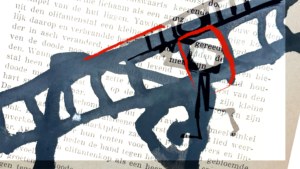“The South Route to Tarascon”
Willem Boronski, known for his poignant art videos, unveils his latest work, “The South Route to Tarascon,” a compelling companion piece to his forthcoming “The North Road to Tarascon.” These works together embody a profound message: migration, a journey as old as humanity itself, transcends direction and time. Boronski draws inspiration from Vincent van Gogh’s “The Painter on the Road to Tarascon,” embedding the theme of amor fati – the love and acceptance of one’s fate – into the very fabric of his narrative.

“The South Route to Tarascon” delves into the theme of human migration, a narrative thread that has run through the tapestry of human history. Boronski employs his signature stop-motion animation technique, using ink and charcoal drawings, paper cutouts, and pages from ancient texts. These materials are artistic tools and serve as poignant symbols of the stories and myths that have fueled human migrations for centuries, from the Vikings’ southward conquests to modern journeys in pursuit of new horizons.

In this video, Boronski echoes Van Gogh’s journey to Tarascon, highlighting the unchanging essence of human movement. The central motif of the piece – a rectangle symbolizing the television – reflects the modern version of ancient stories told around campfires, stories that have shaped and influenced human destiny across ages. The ladder, a recurring symbol in the video, represents humanity’s relentless pursuit of power, knowledge, and a better life, echoing the Vikings’ ambitious voyages.

The idea of amor fati is intricately intertwined into “The South Route to Tarascon.” Just like Van Gogh, who accepted his path with all its inherent challenges and joys, the characters in Boronski’s video embrace their journey with a similar resolve. This theme of embracing one’s fate, regardless of its challenges, is a powerful reflection of the experiences of migrants explored in the video. The blue color of the evil eye, a symbol that appears throughout the narrative, serves as a reminder of the deceptive nature of appearances, particularly in the stories spun by the modern media.
Boronski has a unique creative process where the story develops naturally from the visuals. This results in a final cut that is both cohesive and deeply evocative. His work reflects on the unchanging nature of human desire and ambition, which remains relevant today, just as it was during the Viking era.

“The South Route to Tarascon” is more than an art video; it’s a reflection on the human condition, a discussion on the impact of story telling and modern media on migration, and an appeal for a deeper understanding of the motivations behind migration. It invites viewers to contemplate the dreams that drive us and the horizons we chase, reminding us that the journey of migration is an intrinsic part of human history and destiny.
Experience the stirring narrative of “The South Route to Tarascon” and join in the conversation about the ancient and ongoing saga of human migration, where the acceptance of one’s journey, as epitomized by amor fati, remains a timeless and universal truth.


